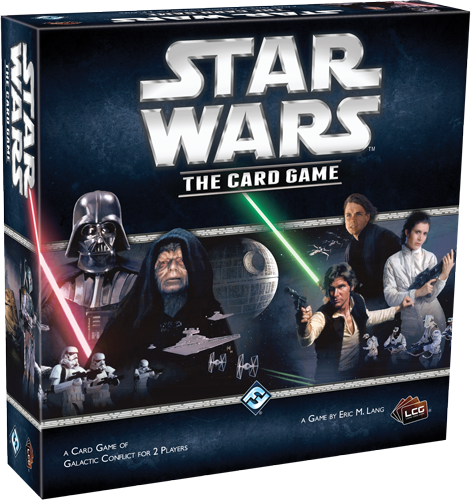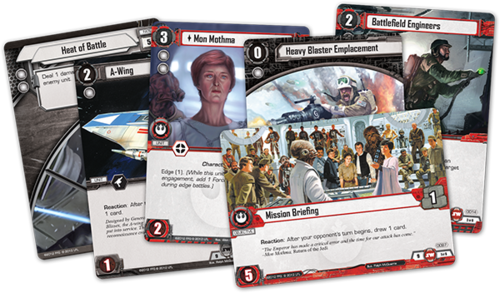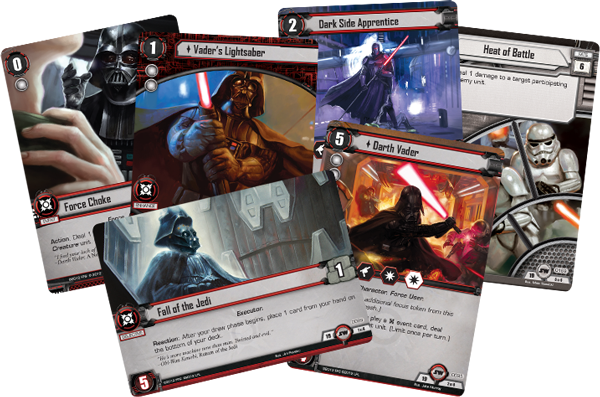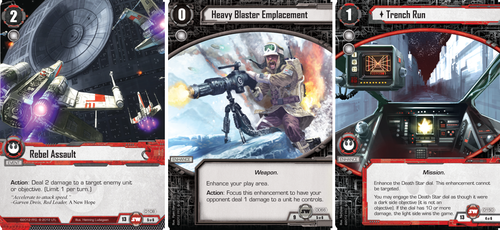We Review Star Wars The Card Game
/By Jeremiah
 A long time ago, but not so far away, the folks at Fantasy Flight promised us all a new title in their Living Card Game (LCG) catalog—this time coming from the Star Wars universe. Well about a year ago they scrapped the original concept, and completely overhauled the game. It took some time, and many folks were frustrated with the lengthy wait (including myself at times!). But Fantasy Flight Games wanted to make the game the best gaming experience possible.
A long time ago, but not so far away, the folks at Fantasy Flight promised us all a new title in their Living Card Game (LCG) catalog—this time coming from the Star Wars universe. Well about a year ago they scrapped the original concept, and completely overhauled the game. It took some time, and many folks were frustrated with the lengthy wait (including myself at times!). But Fantasy Flight Games wanted to make the game the best gaming experience possible.
The final version of the game made its way to stores this week, so I grabbed up a copy and gave it a test drive!
The game is a head-to-head battle between the two sides of the Force (Light side and Dark side). The way a player wins the game depends on which side they are on. The Light side wins if they destroy three of the Dark side's Objective cards (each player has a 10-card objective deck, which gives them resources and other game enhancements). The Dark side achieves victory by reaching 12 on the "Death Star Counter," which always increases by at least one at the start of the Dark side player's turn. This seems a bit unfair at first, but simulates the the vast availability of resources and troops that the Empire has at the ready; without the tenacity of the Rebels and/or Jedi, the Empire will simply win out by outlasting their opponent.
Player turns are about what you would expect from an LCG: a refresh phase, a drawing phase, deployment, conflict, and finally a force phase.
Players put cards into play—units (characters, creatures, droids, or vehicles), and enhancements—by paying with resources from their objective cards. Once they have their units in play, they can choose to attack their opponent's objective (both Light and Dark side players always attack the objectives of their opponents). When they attack, the other player chooses to defend or not, and then chooses a defending unit. Once a defending unit is chosen there is an Edge Battle—one of the more unique areas of the game. Edge battles work like this: Each card in the game has a number of Force icons on it. Players take turns adding cards face down from their hands to the Edge Battle until they both pass. Once players are done adding cards, they're turned face up and the icons are tallied; whoever wins the Edge Battle gets first strike in the conflict, and there are also certain attacks/powers that are only activated on units if they have won the Edge Battle. After the Edge Battle is resolved, the units deal out damage either to an opposing unit or to the targeted objective.
 Once conflicts are settled, the player moves on to the Force Phase. Players can commit units to the Force by placing one of three available Force cards; once a unit is committed to the Force they add Force icons to the Force struggle. This is good. The bad thing is that if you use them in a conflict when you "focus" them, you have to place two focus tokens on them. This is bad, because on each turn during your refresh phase, you can only remove 1 token at a time. The balance of the Force is an important facet of the game; if the balance is in favor of the Light side, the Light side player gets to place a damage token on one of the Dark side's objectives at the beginning of their turn. If the balance is in favor of the Dark side, that player gets to increase the Death Star counter by +1 (for a total of two) at the beginning of their turn. So keeping the balance in your favor becomes a big deal!
Once conflicts are settled, the player moves on to the Force Phase. Players can commit units to the Force by placing one of three available Force cards; once a unit is committed to the Force they add Force icons to the Force struggle. This is good. The bad thing is that if you use them in a conflict when you "focus" them, you have to place two focus tokens on them. This is bad, because on each turn during your refresh phase, you can only remove 1 token at a time. The balance of the Force is an important facet of the game; if the balance is in favor of the Light side, the Light side player gets to place a damage token on one of the Dark side's objectives at the beginning of their turn. If the balance is in favor of the Dark side, that player gets to increase the Death Star counter by +1 (for a total of two) at the beginning of their turn. So keeping the balance in your favor becomes a big deal!
My thoughts—
Edge Battles—To be honest, when I first heard about the Edge Battles I thought they sounded a little like the battles in the old Young Jedi CCG from the late 90's, and, well, the prospect of playing that game again sounded about as fun as a root canal. That's not the case, though. The key is to play slowly your first turn or two, so you can get some units on the table and still have some cards in your hand to win the Edge Battles. The advantage to winning an Edge Battle is typically worth the sacrifice to get the win.
 The Artwork—I'm really glad we didn't get another rehash of screen shots from the films, and designers trying to be clever with some obscure character or item in the background that is only seen for three frames. The artwork is beautiful, and also gives a means to incorporate some of the more popular characters from the novels, and other stories in the Star Wars universe. They really outdid themselves in this department—the cards look great!
The Artwork—I'm really glad we didn't get another rehash of screen shots from the films, and designers trying to be clever with some obscure character or item in the background that is only seen for three frames. The artwork is beautiful, and also gives a means to incorporate some of the more popular characters from the novels, and other stories in the Star Wars universe. They really outdid themselves in this department—the cards look great!
Deck-Building—This is another innovative approach to an LCG. Instead of hand-picking each card and building your deck in that manner, you create decks by selecting your 10 objective cards, and each objective card has a five-card set that corresponds to it. By selecting an objective card, you're also selecting the other five cards to go in your "command" deck. This offers a quicker solution to deck-building for beginners, and a challenge for veteran gamers. It's a unique twist on the concept that I like; instead of spending hours tweaking your deck, you can easily swap a couple objective cards/sets and wham!—you've got a new gaming experience!
Overall— I'm sold on the game! The mechanics and card abilities are deep, making the learning curve somewhat slow. And finding card synergy seems a little more difficult than in other games. The upside is that because there's so much attention to detail, not just in the game components, but in how the different characters, items, and locations interact with one another in the Star Wars universe, that it makes for a very deep and nuanced experience for gamers and Star Wars fans. It's a real collision of two worlds. The only real downside is that the multiplayer support is (at this time) not the greatest. I see a great potential for running almost a campaign style of game with multiple players controlling different factions, but for now there isn't much there for gamers who want to bring more than one other player along for the ride.
It took a long time for this game to get to market, but it feels like Fantasy Flight got it right in the end, and that makes it worth the wait.
Thanks for reading! And if you missed it, we interviewed Eric Lang, designer of Star Wars The Card Game—you can read that interview here!














